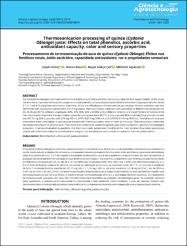| dc.contributor.author | Yıkmış, Seydi | |
| dc.contributor.author | Aksu, Harun | |
| dc.contributor.author | Çöl, Başak Gökçe | |
| dc.contributor.author | Alpaslan, Mehmet | |
| dc.date.accessioned | 2019-12-29T15:24:44Z | |
| dc.date.available | 2019-12-29T15:24:44Z | |
| dc.date.issued | 2019 | en_US |
| dc.identifier.issn | 1413-7054 | |
| dc.identifier.issn | 1981-1829 | |
| dc.identifier.uri | https://hdl.handle.net/11363/1591 | |
| dc.description.abstract | Quince (Cydonia oblonga) is an important fruit for the juice industry because of its nutritional properties that support health. In this study, the aim was to optimize the bioactive components (total phenolic content, ascorbic acid and total antioxidant capacity) and color values (L*, a* and b*) using thermosonication treatment, which is a mild ultrasound treatment, on quince juice. Sensory evaluation was also performed with optimization parameters. For this purpose, thermosonication treatment was completed at different temperatures (30, 35, 40, 45 and 50 degrees C), different amplitudes (40%, 45%, 50%, 55% and 60%) and at different times (2, 4, 6, 8 and 10 min). At the end of the thermosonication treatment, the optimization values for quince juice were 38.7 degrees C, 5.6 minutes and 50.9 amplitude. Total phenolic content was 591.15 mg GAE/L, ascorbic acid 3.78 mg/100 mL, DPPH 0.214 mg TEAC/mL and CUPRAC 0.149 mg TEAC/mL. Total phenolic and total antioxidant levels were higher in quince juice treated with thermosonication than in fresh quince juice. Thermosonication treatment decreased the amount of ascorbic acid. Thermosonation treatments applied to quince juices were successful in general microbiological evaluation. In sensory evaluation by panelists, the thermosonicated sample was found to be the most admired. As a result, quince juice treated with thermosonication is considered promising to improve bioactive components compared to thermal pasteurization. | en_US |
| dc.description.sponsorship | Tekirdag Namik Kemal University-Scientific Research Coordination Unit NKUBAP.48 DS.19.207 | en_US |
| dc.language.iso | eng | en_US |
| dc.publisher | UNIV FEDERAL LAVRAS-UFLA, CAIXA POSTAL 3037, LAVRAS, MG 37200-000, BRAZIL | en_US |
| dc.relation.isversionof | 10.1590/1413-7054201943019919 | en_US |
| dc.rights | info:eu-repo/semantics/openAccess | en_US |
| dc.rights | Attribution-NonCommercial-NoDerivs 3.0 United States | * |
| dc.rights.uri | http://creativecommons.org/licenses/by-nc-nd/3.0/us/ | * |
| dc.subject | Non-thermal | en_US |
| dc.subject | ultrasound | en_US |
| dc.subject | pasteurization | en_US |
| dc.subject | HIGH-INTENSITY ULTRASOUND | en_US |
| dc.subject | SACCHAROMYCES-CEREVISIAE | en_US |
| dc.subject | STRAWBERRY JUICE | en_US |
| dc.subject | FRUIT JUICES | en_US |
| dc.subject | SONICATION | en_US |
| dc.subject | QUALITY | en_US |
| dc.subject | FOOD | en_US |
| dc.subject | INACTIVATION | en_US |
| dc.subject | FLAVONOIDS | en_US |
| dc.subject | STABILITY | en_US |
| dc.title | Thermosonication processing of quince (Cydonia Oblonga) juice: Effects on total phenolics, ascorbic acid, antioxidant capacity, color and sensory properties | en_US |
| dc.title.alternative | Processamento de termosonicação do suco de quince (Cydonia Oblonga): Efeitos nos fenólicos totais, ácido ascórbico, capacidade antioxidante, cor e propriedades sensoriais | en_US |
| dc.type | article | en_US |
| dc.relation.ispartof | Ciência e Agrotecnologia | en_US |
| dc.department | Sağlık Bilimleri Yüksekokulu | en_US |
| dc.identifier.volume | 43 | en_US |
| dc.relation.publicationcategory | Makale - Uluslararası Hakemli Dergi - Kurum Öğretim Elemanı | en_US |



















